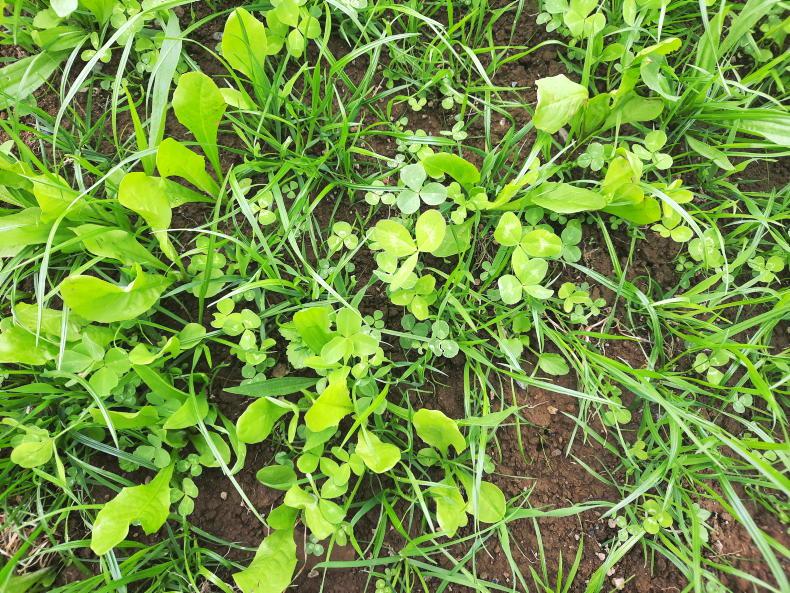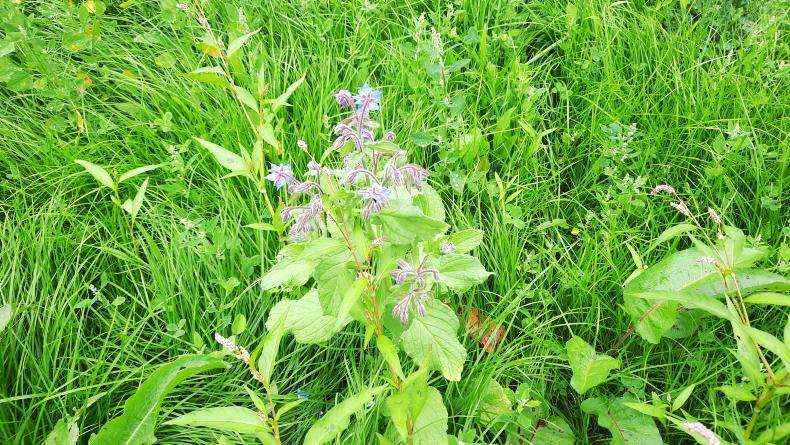Improving genetics
Tullamore Farm is constantly trying to improve the genetics of the herd, resulting in more efficient animal performance.
Performance recording is carried out to choose the best replacements and sire performance is examined carefully.
This can help to improve profitability as well as helping to reduce methane emissions from animals.
Performance recording has also been carried out in the sheep flock for the past three seasons.
Vaccination and dosing
Vaccination is important as it prevents illness and improves animal performance.
Cattle on the farm are vaccinated against leptospirosis, BVD, IBR, pneumonia, clostridial diseases and scour.
Faecal sampling is carried out to determine dosing requirements in sheep and cattle. This ensures that anthelmintics are only used when needed.
Bulls finished at 16 months or less
Earlier slaughtering of animals results in lower methane emissions.
Improving the genetics of the animals on the farm and producing high-quality
grass helps animals to reach their weights on time.
Watercourses are fenced
Animals are fenced away from watercourses. A fence is placed 1.5m from watercourses.
Labour efficiency
Contractors are used for jobs such as spreading slurry, harvesting silage, reseeding and hedgerow maintenance. This frees up time at busy periods in the year and takes out the need to purchase and maintain machinery. Lambing and calving are seasonal. Calving is completed in 10-11 weeks, while the main lambing period is four weeks.
Maximising grass utilisation
Grass utilisation is very important on the farm as it helps to reduce the amount of feed bought in.
Grass measuring is carried out and the mixed grazing of cattle and sheep allows grass to be used very efficiently. Some of the drier land in Cloona allows for early turnout.
Over 95% of the suckler cows’ and heifers’ diets on the farm is grass or grass silage, while 60% of the lifetime diet of the bulls is forage or milk-based.
Grass takes up 90% of the diet across the sheep flock. Strategic use is made of concentrates to finish lambs.
LESS and protected urea
Low-emission slurry spreading equipment is used to apply all slurry on the farm. This reduces ammonia emissions and can result in more efficient nutrient use.
Protected urea is used across the farm to reduce emissions from nitrogen applications.
What changes have we made in the past
12 months?
Over the past 12 months we have made a lot of changes on the farm to try and improve its sustainability. Some of these actions are outlined below.
Some are simple actions to take and while some will cost money like testing slurry or silage this investment should see a return. Others, like carbon testing are more difficult to implement on farm.
Measuring to manage
Soil testing, slurry testing and silage testing has all been carried out. This allows nutrients to be targeted where they are needed most and allows silage of different quality to be targeted at certain animals.
Soil carbon testing
The whole farm was sampled for carbon to a depth of 30cm this spring. These samples will allow us to see if soil carbon increases over time on the farm.
Offsetting emissions
We have planted a new hedge and will consider planting more under the new eco schemes in the CAP. We also have 0.2ac dedicated to nature on the farm which allows wildflowers to grow.

The multispecies sward on Tullamore farm.
Nitrogen reduction
Nitrogen reduction is a major target to reduce costs, reduce emissions and reduce the risk of nitrogen entering water. Clover content is good and we have now started to cut out artificial nitrogen use on paddocks with high clover contents.
We have also planted multispecies swards and red clover. These swards received 100kg/ac (two bags) of 10-10-20 at sowing in mid-May and will not receive any more nitrogen for the remainder of the season.
The red clover should also contribute to a reduction in concentrate use on the farm.

Red clover on Tullamore farm.
Improving P and K indices is also an important part of nitrogen reduction as soils at optimum levels for pH, P and K will perform better than those at lower indices. Clover should also perform better in these swards.
This action will help to reduce input costs while helping to reduce the farm’s impact on the environment.
Water quality
As well as reducing nitrogen use we have cambered roadways on the farm to show no run-off is entering water. We are also trying to identify critical source areas for nutrient loss and will look at planting buffers in these locations like a hedgerow.

The roadways have been cambered away from watercourses.
Biodiversity
The space for nature on the farm has been estimated at 4% and will now be ground truthed. We have a dedicated area for nature on the farm.

A wildflower in the space for nature on Tullamore Farm.
Hedgerows are in compliance with the nitrates derogation, bird and owl boxes have been installed.
Improving genetics
Tullamore Farm is constantly trying to improve the genetics of the herd, resulting in more efficient animal performance.
Performance recording is carried out to choose the best replacements and sire performance is examined carefully.
This can help to improve profitability as well as helping to reduce methane emissions from animals.
Performance recording has also been carried out in the sheep flock for the past three seasons.
Vaccination and dosing
Vaccination is important as it prevents illness and improves animal performance.
Cattle on the farm are vaccinated against leptospirosis, BVD, IBR, pneumonia, clostridial diseases and scour.
Faecal sampling is carried out to determine dosing requirements in sheep and cattle. This ensures that anthelmintics are only used when needed.
Bulls finished at 16 months or less
Earlier slaughtering of animals results in lower methane emissions.
Improving the genetics of the animals on the farm and producing high-quality
grass helps animals to reach their weights on time.
Watercourses are fenced
Animals are fenced away from watercourses. A fence is placed 1.5m from watercourses.
Labour efficiency
Contractors are used for jobs such as spreading slurry, harvesting silage, reseeding and hedgerow maintenance. This frees up time at busy periods in the year and takes out the need to purchase and maintain machinery. Lambing and calving are seasonal. Calving is completed in 10-11 weeks, while the main lambing period is four weeks.
Maximising grass utilisation
Grass utilisation is very important on the farm as it helps to reduce the amount of feed bought in.
Grass measuring is carried out and the mixed grazing of cattle and sheep allows grass to be used very efficiently. Some of the drier land in Cloona allows for early turnout.
Over 95% of the suckler cows’ and heifers’ diets on the farm is grass or grass silage, while 60% of the lifetime diet of the bulls is forage or milk-based.
Grass takes up 90% of the diet across the sheep flock. Strategic use is made of concentrates to finish lambs.
LESS and protected urea
Low-emission slurry spreading equipment is used to apply all slurry on the farm. This reduces ammonia emissions and can result in more efficient nutrient use.
Protected urea is used across the farm to reduce emissions from nitrogen applications.
What changes have we made in the past
12 months?
Over the past 12 months we have made a lot of changes on the farm to try and improve its sustainability. Some of these actions are outlined below.
Some are simple actions to take and while some will cost money like testing slurry or silage this investment should see a return. Others, like carbon testing are more difficult to implement on farm.
Measuring to manage
Soil testing, slurry testing and silage testing has all been carried out. This allows nutrients to be targeted where they are needed most and allows silage of different quality to be targeted at certain animals.
Soil carbon testing
The whole farm was sampled for carbon to a depth of 30cm this spring. These samples will allow us to see if soil carbon increases over time on the farm.
Offsetting emissions
We have planted a new hedge and will consider planting more under the new eco schemes in the CAP. We also have 0.2ac dedicated to nature on the farm which allows wildflowers to grow.

The multispecies sward on Tullamore farm.
Nitrogen reduction
Nitrogen reduction is a major target to reduce costs, reduce emissions and reduce the risk of nitrogen entering water. Clover content is good and we have now started to cut out artificial nitrogen use on paddocks with high clover contents.
We have also planted multispecies swards and red clover. These swards received 100kg/ac (two bags) of 10-10-20 at sowing in mid-May and will not receive any more nitrogen for the remainder of the season.
The red clover should also contribute to a reduction in concentrate use on the farm.

Red clover on Tullamore farm.
Improving P and K indices is also an important part of nitrogen reduction as soils at optimum levels for pH, P and K will perform better than those at lower indices. Clover should also perform better in these swards.
This action will help to reduce input costs while helping to reduce the farm’s impact on the environment.
Water quality
As well as reducing nitrogen use we have cambered roadways on the farm to show no run-off is entering water. We are also trying to identify critical source areas for nutrient loss and will look at planting buffers in these locations like a hedgerow.

The roadways have been cambered away from watercourses.
Biodiversity
The space for nature on the farm has been estimated at 4% and will now be ground truthed. We have a dedicated area for nature on the farm.

A wildflower in the space for nature on Tullamore Farm.
Hedgerows are in compliance with the nitrates derogation, bird and owl boxes have been installed.










 This is a subscriber-only article
This is a subscriber-only article











SHARING OPTIONS: